Orchids are a beautiful and popular type of flower, but they are also susceptible to a number of viruses. In this article, we will take a look at eight of the most common orchid viruses and how to deal with them.
Actual Signs of Viral Infection In Orchids
Orchids are one of the most popular houseplants, but they are also susceptible to viral infections. Here are some of the most common signs of a viral infection in orchids:
Yellow or white spots on the leaves: These spots are usually one of the first signs of a viral infection in orchids. 1.
2. stunted growth: If your orchid is not growing as quickly as it should be, it may be infected with a virus.
3. flowers that are smaller than normal: Viruses can cause the flowers of an orchid to be smaller than usual.
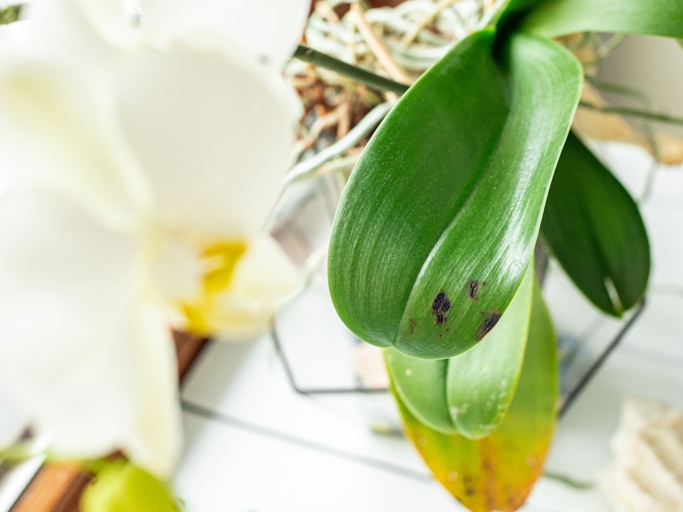
4. distorted leaves: The leaves of an orchid with a viral infection may be distorted or have abnormal growth.
If you notice any of these signs, it is important to take your orchid to a professional for diagnosis and treatment.
Ways That A Virus Can Get Into A Houseplant
Viruses are tiny, infectious particles that can cause serious diseases in plants. They are spread in many ways, including through the air, water, soil, and even on the clothes and shoes of people who have been in contact with infected plants.
One way is through the soil. There are several ways that a virus can get into a houseplant. If the plant is grown in soil that is contaminated with a virus, the plant can become infected. Another way is through the water. If the plant is watered with water that contains a virus, the plant can become infected.
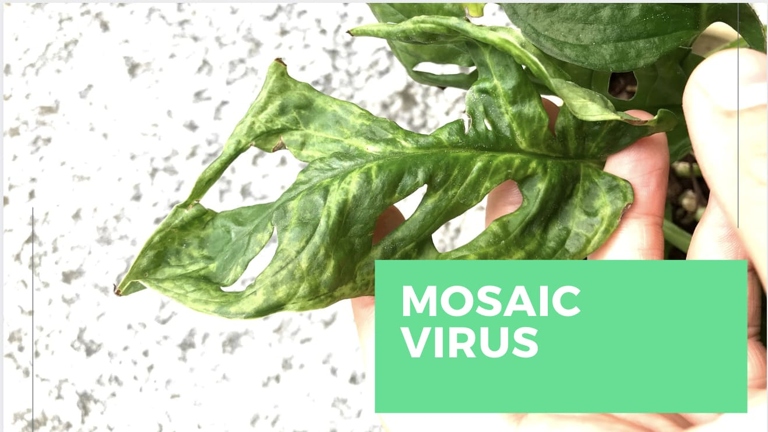
Viruses can also be spread by insects. If an insect bites an infected plant, the virus can be transmitted to the plant. If a person touches an infected plant, the virus can be transmitted to the plant. Finally, viruses can be spread by people.
Finally, it is important to keep infected plants away from healthy plants. One way is to grow plants in sterile soil. Another way is to water plants with sterile water. There are several ways to prevent the spread of viruses.
Can Viral Diseases In Orchids Be Cured?
Orchids are beautiful, delicate flowers that are unfortunately susceptible to a number of viral diseases. While there is no cure for these diseases, there are some things that can be done to help prevent them from spreading and to keep your plants healthy.

These include keeping your plants clean and free of pests, and quarantine any new plants that you bring into your collection. This virus is spread by aphids and other insects and can cause the leaves of the plant to turn yellow or brown and the flowers to become deformed. One of the most common viral diseases in orchids is called Cymbidium mosaic virus (CymMV). While there is no cure for CymMV, there are some things that can be done to prevent it from spreading.
Another common viral disease is Phalaenopsis mosaic virus (PhalMV). While there is no cure for PhalMV, there are some things that can be done to prevent it from spreading. This virus is also spread by insects and can cause the leaves of the plant to turn yellow or brown and the flowers to become deformed. These include keeping your plants clean and free of pests, and quarantine any new plants that you bring into your collection.
While there is no cure for these diseases, early detection and treatment can help to prevent them from spreading and keep your plants healthy. If you think that your orchid has a viral disease, the best thing to do is to take it to a qualified professional for diagnosis and treatment.
The Most Common Species of Orchid Viruses
There are eight common types of orchid viruses, and here is a brief overview of each one. Orchids are a beautiful and popular flower, but they are also susceptible to viruses.
CymMV is difficult to control and can quickly spread to other plants, so it is important to remove infected plants from your garden as soon as possible. The most common orchid virus is the Cymbidium mosaic virus (CymMV). This virus is spread by aphids and causes yellow or white mottling on the leaves of infected plants.
ORSV is easier to control than CymMV, but it can still cause serious damage to your plants. This virus is spread by thrips and causes small, dark spots on the leaves of infected plants. The next most common virus is the Odontoglossum ringspot virus (ORSV).
The third most common virus is the Oncidium mosaic virus (OncMV). OncMV is difficult to control and can quickly spread to other plants, so it is important to remove infected plants from your garden as soon as possible. This virus is spread by mealybugs and causes yellow or white mottling on the leaves of infected plants.
The fourth most common virus is the Phalaenopsis mosaic virus (PhaMV). PhaMV is easier to control than OncMV, but it can still cause serious damage to your plants. This virus is spread by thrips and causes small, dark spots on the leaves of infected plants.
The fifth most common virus is the Sophronitis mosaic virus (SophMV). This virus is spread by thrips and causes small, dark spots on the leaves of infected plants. SophMV is easier to control than PhaMV, but it can still cause serious damage to your plants.
This virus is spread by thrips and causes small, dark spots on the leaves of infected plants. The sixth most common virus is the Zygopetalum mosaic virus (ZygMV). ZygMV is easier to control than SophMV, but it can still cause serious damage to your plants.
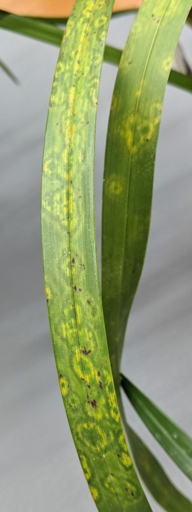
The seventh most common virus is the Brassavola nodosa virus (BrNV). This virus is spread by thrips and causes small, dark spots on the leaves of infected plants. BrNV is easier to control than ZygMV, but it can still cause serious damage to your plants.
This virus is spread by thrips and causes small, dark spots on the leaves of infected plants. The eighth and final common virus is the Dendrobium mosaic virus (DenMV). DenMV is easier to control than BrNV, but it can still cause serious damage to your plants.
If you think your orchid has any of these viruses, it is important to take action immediately. Remove infected plants from your garden and destroy them to prevent the virus from spreading. You should also disinfect your tools and equipment to prevent the virus from spreading to healthy plants.
Orchid fleck virus (OFV)
There are a few things you can do to help prevent the spread of OFV: Orchid fleck virus (OFV) is a common virus that can affect many different types of Orchids. The virus is spread by aphids and other insects and can cause the leaves of the Orchid to develop small, raised bumps or flecks. This can eventually lead to the leaves turning yellow or brown and falling off. OFV is difficult to control and can be devastating to Orchids, so it is important to take measures to prevent it from spreading.
-Remove affected leaves from the Orchid as soon as possible.
-Isolate any Orchids that show signs of OFV.
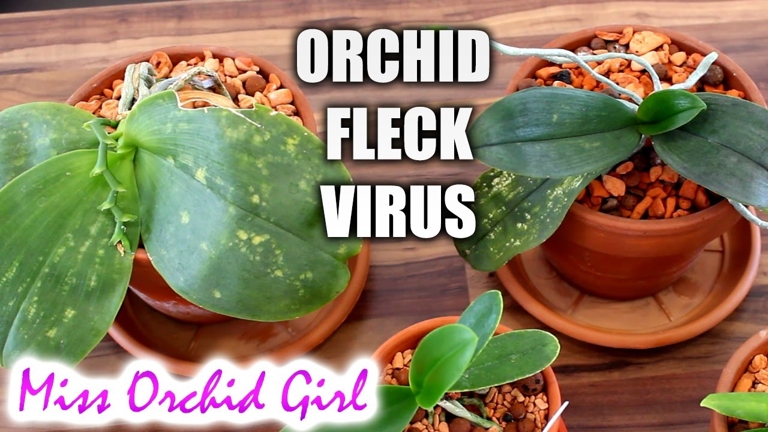
-Apply insecticidal soap or neem oil to the Orchid to help kill any insects that may be carrying the virus.
-Avoid using any chemicals on the Orchid that could potentially stress it out and make it more susceptible to OFV.
If you suspect that your Orchid has OFV, it is important to take action immediately to prevent the virus from spreading. By taking some simple precautions, you can help keep your Orchid healthy and free from this devastating virus.
Dendrobium mosaic virus (DeMV)
Symptoms of DeMV include yellow or white mosaic patterns on the leaves, stunted growth, and reduced flowering. Orchids are susceptible to a wide range of viruses, including the dendrobium mosaic virus (DeMV). Aphids can be controlled with insecticides. DeMV can be controlled by removing infected plants and destroying them. DeMV is a potexvirus that is transmitted by aphids.
Tobacco Mosaic Virus (TMV)
If you suspect that your plant is infected with TMV, isolate it from other plants and contact your local extension office for diagnosis and treatment options. Tobacco mosaic virus (TMV) is a plant virus that is transmitted by contact with contaminated tobacco products or by contact with infected plants. The best way to prevent TMV is to avoid contact with contaminated tobacco products or infected plants. TMV is difficult to control and can be spread easily from plant to plant. Symptoms of TMV include mosaic patterns on leaves, stunted growth, and reduced flower production.
Odontoglossum Ringpot Virus (ORSV)
The virus is transmitted by aphids and causes the plant to produce small, deformed flowers. Infected plants may also produce fewer flowers and leaves. Odontoglossum ringpot virus (ORSV) is a plant virus that affects orchids.
The virus can be controlled by removing infected plants and destroying them. Chemical controls are also available, but they are not always effective. Symptoms of ORSV include small, deformed flowers and fewer flowers and leaves.

If you suspect that your plant is infected, it is important to take action immediately to prevent the spread of the virus. ORSV is a serious virus that can cause significant damage to orchids.
Phalaenopsis Chlorosis Spot Virus (PhCSV)
The virus is spread by aphids and other insects that feed on the plant. Symptoms of the virus include yellow or white spots on the leaves, stunted growth, and flowers that do not open properly. Phalaenopsis chlorosis spot virus (PhCSV) is a virus that affects orchids. The virus can be controlled by removing infected plants, controlling aphids and other insects, and using sterile growing conditions.
Turnip Mosaic Virus (TuMV)
Infected plants display mosaic patterns on their leaves, and may also experience stunted growth, flower abortion, and reduced yields. The virus is spread by aphids and other insects, and can also be transmitted through contaminated seed. Turnip mosaic virus (TuMV) is a plant virus that primarily affects crops in the Brassica genus, including turnips, cabbage, and broccoli. These include using clean seed, controlling insect populations, and destroying infected plants. TuMV is difficult to control once it has infected a crop, but good agricultural practices can help to prevent its spread.
Calanthe Mild Mosaic Potyvirus (CalMMV)
The best way to prevent it from spreading is to keep infected plants away from healthy plants. If you suspect that your plant has CalMMV, you should contact a professional for help. It is transmitted by aphids and causes the leaves of the plant to become mottled and discolored. The virus can also cause the flowers to become deformed. CalMMV is difficult to control and there is no cure for the virus. Calanthe Mild Mosaic Potyvirus (CalMMV) is a virus that affects orchids.
Capsicum Chlorosis Virus
There is no cure for CCV, and infected plants must be destroyed. CCV is a serious problem in tropical and subtropical regions, where it can cause complete crop loss. Capsicum chlorosis virus (CCV) is a plant virus that affects members of the Solanaceae family, which includes peppers (Capsicum annuum), tomatoes (Solanum lycopersicum), and eggplants (Solanum melongena). CCV is transmitted by whiteflies (Bemisia tabaci), and causes symptoms including yellowing of leaves, stunted growth, and reduced fruit yield. To prevent CCV, growers should practice good whitefly control, and avoid planting susceptible crops in areas where the virus is known to occur.
How To Tell The Difference Between A Virus And Other Diseases?
Second, viruses are more likely to be contagious than other diseases. Finally, viruses are more likely to cause death than other diseases. First, viruses tend to cause more severe symptoms than other diseases. There are a few key ways to tell the difference between a virus and other diseases.
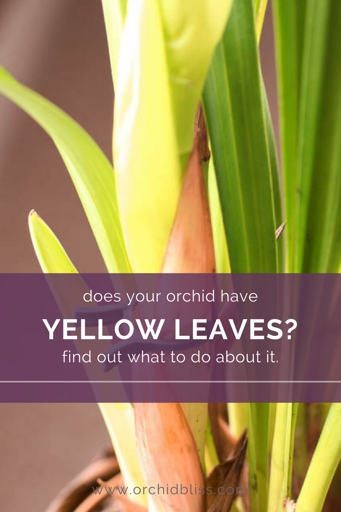
Early diagnosis and treatment is essential for the best possible outcome. If you suspect that you or someone you know has a virus, it is important to seek medical help immediately. Viruses are serious and can be life-threatening.
Frequently Asked Questions
1. What are the 8 common orchid viruses?
2. What are the symptoms of each virus?
3. How can I tell if my orchid has a virus?
4. How do I treat an orchid with a virus?
5. Can I prevent my orchid from getting a virus?
1. The 8 common orchid viruses are: Cymbidium mosaic virus, Odontoglossum ringspot virus, Orchid fleck virus, Orchid mosaic virus, Phalaenopsis mosaic virus, Sacbrood virus, Tobacco mosaic virus, and Tomato black ring virus.
2. The symptoms of each virus vary, but can include: stunted growth, yellow or brown spots on leaves, rings or spots on flowers, and deformities.
3. To tell if your orchid has a virus, you can look for symptoms or have a professional test it.
4. There is no cure for a virus, so you will need to throw away any infected plants. You can try to prevent the spread of the virus by isolating any infected plants.
5. You can prevent your orchid from getting a virus by buying healthy plants, quarantine new plants, and avoid sharing tools or potting mix.
Final thoughts
Orchids are susceptible to a number of viruses, but there are ways to deal with them. The most important thing is to prevent them from spreading. If you suspect your plant has a virus, isolate it from other plants. You can also try to remove the infected parts of the plant. If the virus is severe, you may need to destroy the plant.
